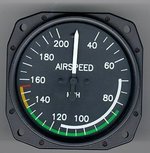Airspeed indicator
|
|
The airspeed indicator is an instrument used in an aircraft to display the craft's airspeed, typically in knots, to the pilot.
| Contents |
Markings
A redline mark indicates VNE, or velocity (never exceed). This is the absolute maximum airspeed that the aircraft must not exceed under any circumstances. The red line is preceded by a yellow band which is the caution area, which runs from VNO (velocity maximum, normal operation) to VNE. A green band runs from VS1 to VNO. VS1 is the stall speed with flaps and landing gear retracted. A white band runs from VS0 to VFE. VS0 is the stall speed with flaps extended, and VFE is the highest speed at which flaps can be extended. Airspeed indicators in multi-engine aircraft show a blue line for Vmc, the speed below which full rudder is insufficient to keep the aircraft from yawing at full power with the critical engine inoperative.
The green range is the normal range of operating speeds for the aircraft with the flaps up. The yellow range is the range in which the aircraft may be operated with caution to avoid turbulence or abrubt control inputs. The white range is the normal range of operating speeds for the aircraft with the flaps down.
At high Density Altitude, the airspeed indicator will show a far lower speed than the aircraft's true airspeed (TAS), but aerodynamically, the same indicated airspeeds apply. The airspeed indicator is especially important for monitoring V-Speeds while operating an aircraft.
Modern aircraft employing glass cockpit instrument systems employ two airspeed indicators: an electronic indicator on the primary flight data panel and a traditional dial or "steam gauge" for use when the electronic panels fail.
Operation
Along with the altimeter and vertical speed indicator, the airspeed indicator is a member of the pitot-static group of aviation instruments, so named because they operate by measuring pressure in the pitot and static circuits.
Airspeed indicators work by measuring the difference between static pressure, captured through one or more static port(s) and dynamic pressure, captured through a pitot tube. The static ports are located on the exterior of the aircraft, at a location chosen to detect the prevailing atmospheric pressure as accurately as possible, that is, without any disturbance from the passage of the aircraft. Some aircraft have static ports on both sides of the fuselage or empennage, in order to more accurately measure static pressure during slips and skids.
The pitot tube accumulates "ram air", that is, air forced against the opening of the tube by the passage of the aircraft. Pitot tubes face forward, in the direction of flight. Icing is a problem for pitot tubes when visible moisture is present in the atmosphere, as when flying through clouds or precipitation. Electrically heated pitots are used to prevent clogging with ice.
The airspeed indicator is rendered inoperative by blockage in the static system. To prevent this, most aircraft intented for use in instrument meterological conditions are equipped with an alternate source of static air. This is usually less accurate, but is still workable.
Use
The primary use of the airspeed indicator is to provide guidance during climb, descent and landing, so that an appropriately slow airspeed is maintained while still operating safely above stall speed and without entering slow flight. During approach and landing, the aircraft is typically operated at airspeeds specified by air traffic control or the aircraft's operating handbook depending on conditions and the phase of the approach. The airspeed indicator is also important for ensuring that structural speeds are not exceeded, beyond which the airframe may be stressed and damaged.
During instrument flight, the airspeed indicator is the primary instrument of reference for pitch control during climbs and descents, and a secondary instrument of reference for pitch control during cruise and turns. A skilled pilot can fly the aircraft using only the altimeter and airspeed indicator (and a navigation source) in instrument conditions.
The airspeed indicator is also used in dead reckoning, where time, speed, and bearing are used for navigation.
Alternatives
The "lift reserve indicator", or LRI, has been proposed but poorly received as an alternative to the airspeed indicator for use during critical stages of flight. The LRI shows the margin of speed above stall speed. Since indicated stall speed varies with conditions (particularly gross weight), the LRI is simpler to use.
Some aircraft are equipped with a ground speed display, which is calculated by radionavigation equipment.
Types of airspeed measurements
Most aircraft exhibit a difference between (theoretical) calibrated airspeed (CAS) and the airspeed actually shown on the instrument (indicated airspeed, or IAS). This position error is mainly due to inaccurate static pressure. It is usually not possible to find locations for the static ports which accurately sense static pressure at all speeds and angles of attack.
Because Bernoulli's principle states that total pressure is constant along a streamline, a pitot tube that is away from the boundary layer and approximately aligned with the local airflow should not cause much position eror.
Position error is typically small (a few percent), and, for small planes, the IAS will be lower than CAS at slow speeds and higher than CAS at high speeds. A calibration chart is usually provided but rarely used.
The true airspeed (TAS), can be calculated as a function of temperature and pressure altitude. Some airspeed indicators incorporate a slide rule mechanism to perform this calculation. Otherwise, it can be performed with a calculator such as the E6B handheld circular slide rule.de:Fahrtmesser pl:Prędkościomierz (lotnictwo)

